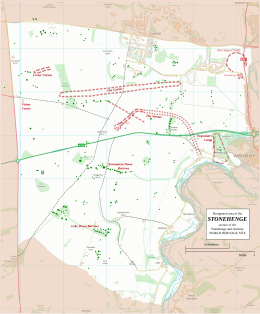Coneybury Henge facts for kids
|
Map showing Coneybury Henge within the Stonehenge section of the Stonehenge and Avebury World Heritage Site
|
|
| Location | OS SU13424160 |
|---|---|
| Region | Wiltshire |
| Coordinates | 51°10′25″N 1°48′33″W / 51.1735°N 1.8093°W |
| Type | Henge |
| History | |
| Periods | Neolithic / Bronze Age |
| Site notes | |
| Excavation dates | 1980 |
| Archaeologists | Stonehenge Environs Project |
| Designated | 1986 |
| Reference no. | 373 |
Coneybury Henge is an ancient circular monument called a henge. It is found in Wiltshire, England, near the famous Stonehenge. This henge was mostly flattened over time, so it was only found in the 1900s. Scientists used special tools and dug into the ground to learn about it. They found an entrance, a circle of holes where wooden posts once stood, and pieces of old bones and pottery.
Finding Coneybury Henge
Coneybury Henge is about 1.4 kilometers (less than a mile) southeast of Stonehenge. You can even see Stonehenge from the henge's location. The site also has great views across the Avon valley.
Why Was Coneybury Henge Hard to Find?
It is very hard to see Coneybury Henge on the ground today. This is because farmers have plowed over it for many years. This plowing made the henge almost completely flat.
How Was Coneybury Henge Discovered?
Even though it's flat, experts found the henge using special methods. They used aerial photographs taken from planes. They also used geophysical surveys. These surveys use special equipment to look underground without digging. Finally, they confirmed its location by digging small areas.
When Was Coneybury Henge Leveled?
Old records do not mention Coneybury Henge. This suggests it might have been flattened a long time ago, perhaps in the Middle Ages. Some aerial photos even show old ridge and furrow marks. These marks are left by ancient plowing methods.
Digging Up Coneybury Henge
The site was first noticed from the air in the 1920s. At first, people thought it was a different type of ancient mound. But later aerial photos showed it was likely a henge. The photos showed an oval ditch, about 45 by 55 meters (148 by 180 feet) wide. Its entrance was on the northeast side.
The 1980 Excavation
Archaeologists dug at Coneybury Henge in 1980. This was part of a bigger project to study the area around Stonehenge. The digging showed a wide oval ditch. It was about 4 meters (13 feet) wide and 3 meters (10 feet) deep. This ditch formed the main shape of the henge.
What Was Found Inside the Henge?
Inside the henge, archaeologists found several pits and postholes. These are holes where wooden posts once stood. They also found many smaller stakeholes. An arc of postholes inside the ditch might have been a circle of wooden posts. Some of these older features might have been there even before the henge was built.
Ancient Finds at the Site
The archaeologists found many interesting things. They found pottery from different time periods. These ranged from the early Neolithic (New Stone Age) to the middle Bronze Age. They also found animal bones and a human cremation (burned human remains).
The Coneybury Anomaly
About 12 meters (39 feet) northwest of Coneybury Henge, something very special was found. It was a pit that suggests an amazing ancient gathering. This pit is called the "Anomaly" because it's so unusual.
What Was in the Anomaly Pit?
The pit contained a lot of early Neolithic pottery. It also had many animal bones. Plus, there were flint tools from both the Mesolithic (Middle Stone Age) and Neolithic periods. This mix of tools from different time periods is very rare.
What Animals Were Found?
The bones included at least ten cattle. There were also several roe deer, two red deer, and a pig. Scientists used radiocarbon dating to find out how old these remains were. They dated back to about 3980-3708 BCE. This was before the henge was built.
A Special Ancient Feast
Experts believe the pit shows evidence of a single, big event. It wasn't a place where people lived for a long time. The pottery pieces were large, meaning they weren't walked on much after being thrown away. This suggests a quick, important event.
Where Did the Animals Come From?
Tests on the bones showed that all the animals came from within 20 kilometers (12 miles) of Coneybury. The cattle came from at least three different places. They were all female and had grazed in open fields. The deer, however, came from the area right around Coneybury.
Two Cultures Meeting?
The pit had a mix of tools from both the Neolithic and Mesolithic periods. This mix is unique. It suggests that two different groups of people came together for this event. One group might have been farmers (Neolithic). The other might have been hunter-gatherers (Mesolithic).
A Feast of Unity
Archaeologists think the Coneybury Anomaly shows a gathering organized by a regional community. People from different areas came together. One group might have brought deer, while others brought cattle. This gathering could have been a "solidarity feast." It was a way for different groups to share and stay connected. It shows that big community feasts might have happened very early in the Neolithic period.


